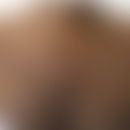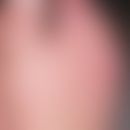Synonym(s)
General informationThis section has been translated automatically.
Material extraction (varies according to Mayser)
The procedure for material extraction depends on the infested structures (see also mycoses).
Cleaning: Carried out with 70% ethyl alcohol or isopropyl alcohol. Removal of the approach flora and possible accompanying germs. No commercial disinfectant sprays, since the culture growth of the mushrooms is impaired by this! Take the sample in the marginal area of the skin changes (here strongest scaling with the highest concentration of fungi). Note: Use of sterile instruments (scalpel, sharp spoon, scissors) is required!
Removal from the marginal area with the blunt side of a scalpel. Superficial and coarse scales are discarded (often only dead fungi and many impurities). Deeper fine scales come for examination. Fine flakes are collected in a plastic container or on a sheet of paper for examination.
Skin material of the interdigits of the toes can easily be removed with tweezers for the examination, and then further mycological processing can be performed. A toe spreader can be used to facilitate the examination (S.u. Tinea pedum).
If the amount of material is insufficient, a strong swab of the surface moistened with common salt can be taken. This is spread directly on the culture plate.
ImplementationThis section has been translated automatically.
Applying to the slide: Several particles of the test material are placed on a slide. Add 1-2 drops of a 20-30% potassium hydroxide solution (KOH;caustic potash solution). Potassium hydroxide solution macerates skin, hair and nail particles, making them transparent. The enclosed fungal elements become microscopically visible due to their stronger light refraction. The slide is covered with a cover glass. Avoid air bubbles! Prepared slides are stored in a moist chamber (e.g. in a closed petri dish with moist cellulose) until they are viewed. It takes varying lengths of time until the desired transparency of the skin particles is achieved, on average about 20 minutes. For nail material, about 1 hour is required. Hair must be microscoped quickly after addition of the caustic potash solution (hair decomposes very quickly; it is then no longer possible to assign the pathogen to a growth form -ektotrixic/endotrixic-).
Reduction of maceration time: Can be achieved by careful heating of the preparation. Do not heat until boiling, formation of KOH crystals! Crystals of KOH can cause false positive results. If TEAH (tetraethylammonium hydroxide - Merck) is used instead of caustic potash solution, the material can be examined immediately under a microscope.
Microscopy: For microscopic examination, the material to be examined is spread in a very thin layer by applying uniform pressure to the cover glass. The evaluation is done by light microscopy. Lower the condenser of the microscope. This produces a sharper image. Alternative: phase contrast examination. Alternative: Staining (Congo red, methylene blue, chlorazole black) of the fungal cells.
Native preparations for pityriasis versicolor (see below pityriasis versicolor)
Microscopic examination for identification at species level: For this purpose, the following preparations are suitable: (1 trickle of lactophenol on slides, plucking fungal elements from the culture, placing them on slides and examining them under the microscope), the adhesive strip-removal preparation (1 trickle of lactophenol on slides, removing fungal elements from the culture by means of adhesive strips which are lightly pressed on, Adhere adhesive strips to slides and microscope) or the cover glass culture (cut 1.0x1.0x0.5 cm agar cubes from Petri dish, place them on slides, inoculate lateral edges, place cover glass, incubate for a few days, then microscope).
Fluorescence examination: Staining of the preparations with Akridinorange or Calcofluor White. Dyes accumulate on certain polysaccharides or on the chitin of fungi (human keratin is only slightly stained). Under the fluorescence microscope, fungal elements glow greenish. Cave: Cellulose (cotton fibres) also fluoresces.
Note(s)This section has been translated automatically.
Yeast differentiation is carried out by means of culture on rice agar.
Skin material from the spaces between the toes can be easily removed with tweezers for the examinations and then further mycologically processed. A toe spreader can be used to facilitate this (see Tinea pedum below).
Histological examination: Larger pieces of nail can also be used for histological diagnosis if necessary. Histological detection of the pathogens is carried out using the PAS reaction.
PCR detection methods: There is also the possibility of diagnosis using the (multiplex) polymerase chain reaction (PCR - e.g. EURO-Array Dermatomycosis - Euroimmun, Groß Gronau). This method impresses with its high sensitivity and speed in diagnostics (Bieber K et. a. 2021). The procedure can detect >50 fungi
GOÄ tips:
- Swabs: these are charged with the number 298. GOÄ no. 298 can be charged several times in the same session if the tissue samples are taken and examined from different body regions. Tissue samples are taken and examined from different regions of the body.
- For the microscopic examination of a native preparation, item 3508 is used.
- After simple staining (e.g. methylene blue), the code 3509 is applied
- After differentiating (gradual use of several color solutions, e.g. Giemsa) staining, 3510 is applied
- No. 4711 GOÄ is to be used for the light microscopic examination for the detection of fungi in native material after preparation (e.g. potassium hydroxide solution).
- No. 4715 GOÄ is to be charged for the cultivation of a culture on a simple culture medium (e.g. Kimmig agar).
- No. 4717 GOÄ is to be charged for the cultivation of a culture on a differentiation medium (e.g. Sabouraud dextrose agar with chromogenic substances).
- Nos. 4715 and 4717 GOÄ can be charged several times per test material (per culture medium used)
- After cultivation, the light microscopic examination of the cultivated fungi can be charged analogously with No. 4710 GO Ä (no staining), if stained with No. 4722. 4722 also several times per examination.
LiteratureThis section has been translated automatically.
- Bieber K et al (2021) DNA-chip based diagnosis of onychomycosis and Tineda pedis. JDDG 20:1112-1122
- Brasch J (2012) News on the diagnosis and therapy of mycoses. Dermatologist 63: 390-395
- Mayser A (2010) Mycological training, part 1: basics of mycological diagnostics. Almirall Hermal 21462 Reinbek.
- Nenoff, P et al. (2014) Mycology - an update part 2: dermatomycoses: clinical picture and diagnosis. JDDG 12:749-778
- Seebacher C et al (2007) Tinea of the free skin. J Dtsch Dermatol Ges 11: 921-926



